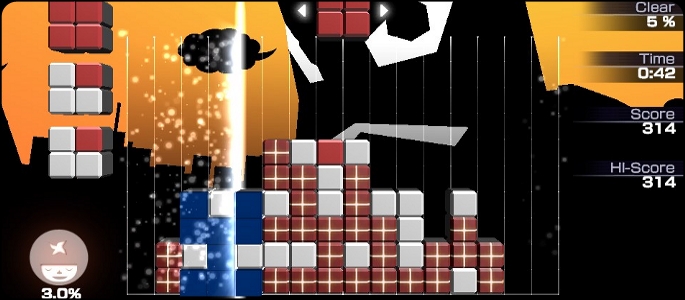I’ve always been someone who enjoys a good puzzle game. Hell, I have a tattoo of Tetris that goes all the way down my forearm. But Lumines combines the essence of fast-paced block-dropping puzzles with heart-pounding electronic music in a match made in heaven. And from the second I picked it up along with my launch PSP, I was sold on Lumines’ formula. Since hearing that yet another Lumines game would launch a PlayStation handheld platform, especially one with a screen as stunning as the Vita’s, I’ve been giddy with anticipation. I’m happy to say, Lumines: Electronic Symphony is a chip off the old block.
Lumines has appeared on a number of platforms at this point, but the formula has remained mostly unchanged – if it ain’t broke don’t fix it. This much is true for Lumines: Electronic Symphony on the PlayStation Vita. Except some new additions, though very minor, are enough to keep the series feeling fresh and exciting.
Square blocks consisting of four smaller shapes drop in different patterns of two colors. It’s up to you to rotate and combine the blocks in such a way so at least four of the same color smaller shapes are touching. Sounds simple, but it’s not. The other element here is that there’s a “timeline” that travels along the screen, starting over when it hits the end. It’s the timeline that does the actual clearing of the matched blocks, and the more blocks you can match before the timeline sweeps by adds a multiplier to your score.

Almost the entire challenge the game offers has to do with the way the patterns fall. And no matter how well you plan out your move, panic can set it quickly the more and faster the blocks fall, and accidental movements can be made that screw up an entire screen’s worth of blocks. You are your own worst enemy here. As you progress, the speed of the timeline can change, as can the speed at which the blocks fall. The entire “skin” changes, too, which means the blocks, the background, even the music switches. You wouldn’t think this would have much of an impact, but some colors and shapes are more difficult for the eye to track, and the quick change-up can throw off even the most perfect of playthroughs.
Adding to the panic and intensity, as well as the enjoyment of the game, are the game’s 43 skins, which feature 34 licensed tracks from well-known electronica artists and some original tracks produced by Q-Entertainment. Q-Entertainment call it a “love letter to electronic music”, hence the name Electronic Symphony, and they sure aren’t kidding. Tracks from the likes of Wolfgang Gartner, The Chemical Brothers, Kaskade, and Benny Benassi help draw you into the intense action on screen. The beats actually can help to keep you focused, and the sounds the blocks make when they rotate and disappear means you’re always putting your own spin on the tracks.

But aside from new music, all of that is pretty standard for Lumines. Avatars have always been a standard in Lumines, but for Electronic Symphony they are more than first meets the eye. Each avatar has its own special abilities; one for single-player and one for duel. These range from the typical Chain Block to a move that stops the timeline, letting you wrack up major multipliers. These can change the tide of a duel or help you get out of a sticky situation (like a screen filled with mismatched blocks). You can’t just use them again and again – you build up a meter as you chain combos and keep scoring. When the meter reaches 100%, you can either save it for when you need it or tap the avatar on the left-hand side and let loose. Strategic planning is important here.
On top of these special abilities, both a Chain Block and a Shuffle block can fall at random. Shuffle Block makes its first appearance in a Lumines game, and at first can seem like a real pain in the ass. When you’re first starting, a shuffle block will screw over any carefully planned out combos you may be preparing by switching the colors of the blocks around below. But after a while, and especially when you’ve amassed a mountain of blocks with colors that cannot be combined easily, it can be a lifesaver by suddenly swapping everything right where you’d want it to be, effectively wiping out entire trouble areas and making that high score sing.

The main mode is appropriately named Voyage, as it takes you through a musical journey through as many of the game’s skins and tracks as you can get through in one play. If you quit after losing, you lose your progress, so I recommend continuing, even if you have to stop playing and just putting your Vita in standby so you can pick up when you’re good and ready – that way you can experience the full Voyage. As noted previously, there’s a Duel mode putting you head to head with a friend via ad-hoc; a Stopwatch mode where you have to score as many points as possible within the chosen time limit; and a Master mode for anyone looking for a serious challenge.
Lumines: Electronic Symphony adds replay value with its EXP system. Think of it as RPG-style leveling – the higher your score, the faster your EXP level goes up. As you level you unlock more avatars and collectibles, which can be gifted to friends using Near. All of your points and leveling contribute to the “World Block”, a giant block that exists online. All contributions from all connected Lumines: ES players combine to chip away at this block. The World Block is kinda a useless addition, but it doesn’t detract in any way.

Like most Vita launch games, Lumines tries to incorporate some touch screen action. Moving blocks can be accomplished by dragging the touchscreen, and rotating can be done by tapping on the screen. It works, but it’s not for anyone looking to take their score seriously. It’s just not as fast as the tried-and-true D-pad and button combinations for how intense the on-screen action can be. Plus, your fingers are in the way. It’s an attempt at least, but the game would have been just fine without it.
I went into this review thinking “what more can I really say about falling blocks?” even though I love the franchise and love this iteration more than any other. And look how long this review turned out. So long that it’s difficult to summarize, but here goes: Lumines: Electronic Symphony is the best Lumines yet, the music is incredible, the new modes and features are a nice touch, and it looks gorgeous and vibrant on the Vita’s OLED screen (a theme among all Vita games, it seems). It’s a must have for anyone who enjoyed it on the PSP (or on any platform), and I couldn’t recommend it more highly as a PlayStation Vita launch title. You can’t go wrong with this purchase.
PlayStation LifeStyle’s Final Score
+ Puzzle-action is intense and addictive. – Vita touch features are tacked on, and don’t work well for the format. |
 |
–








